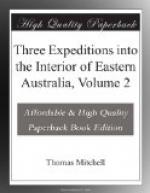NEW AND REMARKABLE SHRUB.
May 27.
In the scrub adjoining our camp we found a new and remarkably beautiful shrub bearing a fruit, the stone of which was very similar to that of the quandang (Fusanus acuminatus) although there was no resemblance either in the form of the tree or of the flower. This shrub was not unlike the weeping willow in its growth, and the fruit, which grew at the extremities of the drooping branches, had the shape of a pear and a black ring at the broad end. The crop then on the tree was unripe, and was probably a second one; the flower was also budding, and we hoped to see the full blossom on our return. Only three or four of these trees were seen, and they were all on the hill near our encampment. Here likewise grew a new shrubby species of Xerotes, with hard rush-like leaves, but allied to X. gracilis.*
(Footnote. X. effusa, Lindley manuscripts; acaulis, foliis linearibus longissimis semiteretibus margine scabris dorso striatis: apice dentato tabescente, panicula mascula effusa abbreviata, bracteis acuminatis scariosis pedicello brevioribus.)
DARLING TRIBE AGAIN.
We proceeded on our journey as usual, but had not gone far when we heard the voices of a vast body of blacks following our track, shouting prodigiously, and raising war cries. It now became necessary for me to determine whether I was to allow the party under my charge to be perpetually subject to be cut off in detail by waiting until these natives had again actually attacked and slain some of my people, or whether it was not my duty, in a war which not my party, but these savages, had virtually commenced, to anticipate the intended blow. I was at length convinced that, unless I could check their progress in our rear and prevent them from following us so closely, the party would be in danger of being compelled to fight its way back against the whole savage population, who would be assembled at that season of drought on the banks of the large rivers. But in order to ascertain first whether this was the hostile tribe I sent overseer Burnett with Piper and half the party into the scrub which skirted our line of route. We were travelling along the berg or outer bank of the river, a feature which not only afforded the best defensive position but also guided me in tracing the river’s course. It was also in many parts the only ground clear of timber or bushes and therefore the best for travelling upon. I directed the men to allow the tribes to pass along our track towards me, as I intended to halt with the carts after crossing the low hill. Piper recognised from this scrub the same people he had seen at Benanee.
DISPERSION OF THE DARLING TRIBE BY THE PARTY.




